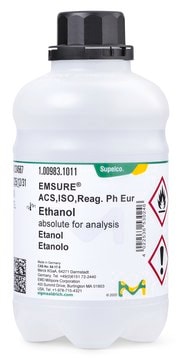Kluczowe dokumenty
1012772
USP
Alkohol odwodniony
United States Pharmacopeia (USP) Reference Standard
Synonim(y):
Ethanol, Ethyl alcohol
About This Item
Polecane produkty
klasa czystości
pharmaceutical primary standard
gęstość pary
1.59 (vs air)
ciśnienie pary
44.6 mmHg ( 20 °C)
temp. samozapłonu
683 °F
granice wybuchowości
19 %, 60 °F
opakowanie
ampule of 5x1.2 mL
producent / nazwa handlowa
USP
współczynnik refrakcji
n20/D 1.3600 (lit.)
bp
78 °C (lit.)
mp
−114 °C (lit.)
Zastosowanie
pharmaceutical (small molecule)
Format
neat
ciąg SMILES
CCO
InChI
1S/C2H6O/c1-2-3/h3H,2H2,1H3
Klucz InChI
LFQSCWFLJHTTHZ-UHFFFAOYSA-N
Szukasz podobnych produktów? Odwiedź Przewodnik dotyczący porównywania produktów
Opis ogólny
Zastosowanie
Komentarz do analizy
Inne uwagi
Przypis
produkt powiązany
Hasło ostrzegawcze
Danger
Zwroty wskazujące rodzaj zagrożenia
Zwroty wskazujące środki ostrożności
Klasyfikacja zagrożeń
Eye Irrit. 2 - Flam. Liq. 2
Kod klasy składowania
3 - Flammable liquids
Klasa zagrożenia wodnego (WGK)
WGK 1
Temperatura zapłonu (°F)
55.4 °F - closed cup
Temperatura zapłonu (°C)
13 °C - closed cup
Wybierz jedną z najnowszych wersji:
Certyfikaty analizy (CoA)
It looks like we've run into a problem, but you can still download Certificates of Analysis from our Dokumenty section.
Proszę o kontakt, jeśli potrzebna jest pomoc Obsługa Klienta
Masz już ten produkt?
Dokumenty związane z niedawno zakupionymi produktami zostały zamieszczone w Bibliotece dokumentów.
Nasz zespół naukowców ma doświadczenie we wszystkich obszarach badań, w tym w naukach przyrodniczych, materiałoznawstwie, syntezie chemicznej, chromatografii, analityce i wielu innych dziedzinach.
Skontaktuj się z zespołem ds. pomocy technicznej






